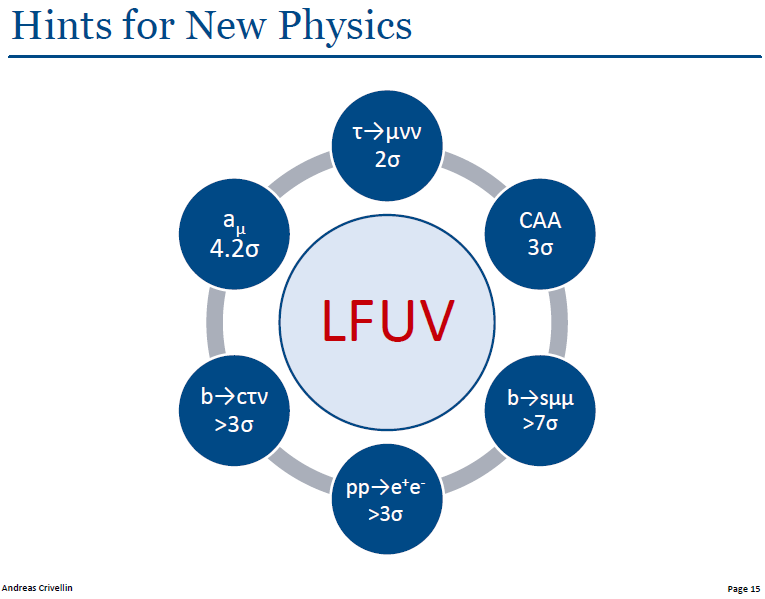nLab flavour anomaly
Update Dec 2022. At long last, the LHCb collaboration in Dec 2022 announced (LHCB22) that they had all along been mis-attributing hadronic backgrounds in the measurement of kaonic decays of B-mesons to electron pairs (as some people had suspected), and that fixing this makes the apparent anomaly in , disappear, and with it most of the other apparent anomalies, too (CFFPSV22). For more see below.
This seems to mean that all the discussion on this page here is essentially obsolete as far as its particle physics content goes – what remains is maybe just of historical/sociological interest.
Context
Fields and quanta
fields and particles in particle physics
and in the standard model of particle physics:
matter field fermions (spinors, Dirac fields)
| flavors of fundamental fermions in the standard model of particle physics: | |||
|---|---|---|---|
| generation of fermions | 1st generation | 2nd generation | 3d generation |
| quarks () | |||
| up-type | up quark () | charm quark () | top quark () |
| down-type | down quark () | strange quark () | bottom quark () |
| leptons | |||
| charged | electron | muon | tauon |
| neutral | electron neutrino | muon neutrino | tau neutrino |
| bound states: | |||
| mesons | light mesons: pion () ρ-meson () ω-meson () f1-meson a1-meson | strange-mesons: ϕ-meson (), kaon, K*-meson (, ) eta-meson () charmed heavy mesons: D-meson (, , ) J/ψ-meson () | bottom heavy mesons: B-meson () ϒ-meson () |
| baryons | nucleons: proton neutron |
(also: antiparticles)
hadrons (bound states of the above quarks)
minimally extended supersymmetric standard model
bosinos:
dark matter candidates
Exotica
Contents
- Idea
- Statistical significance
- Relation to other anomalies
- Status and Outlook
- Possible models
- Related concepts
- References
Idea
In the current standard model of particle physics the fundamental particles in the three generations of fermions have identical properties from one generation to the next, except for their mass, a state of affairs referred to as lepton flavour universality (LFU). A possible violation of lepton flavour universality (LFUV) is also called a flavour anomaly, which, if confirmed, would be a sign of “New Physics” (NP) beyond the standard model.
The presence – or not – of flavour anomalies is part of the general flavour problem of the standard model of particle physics.
Flavor universality pertains in particular to (semi-)leptonic decays of bottom quarks, denoted (in the third generation), into electron/positron pairs, denoted (in the first generation) or muon/antimuon pairs, denoted (in the second generation), the latter two jointly denoted (for “leptons”) in this context.
Since quarks never appear in isolation (due to confinement) but always as bound states to hadrons, decays specifically of bottom quarks manifest themselves in leptonic decays of mesons that contain – B-mesons, denoted –

or as leptonic decays of baryons that contain – Lambda baryons, denoted (measured only more recently (LHCb 19120.8139)).
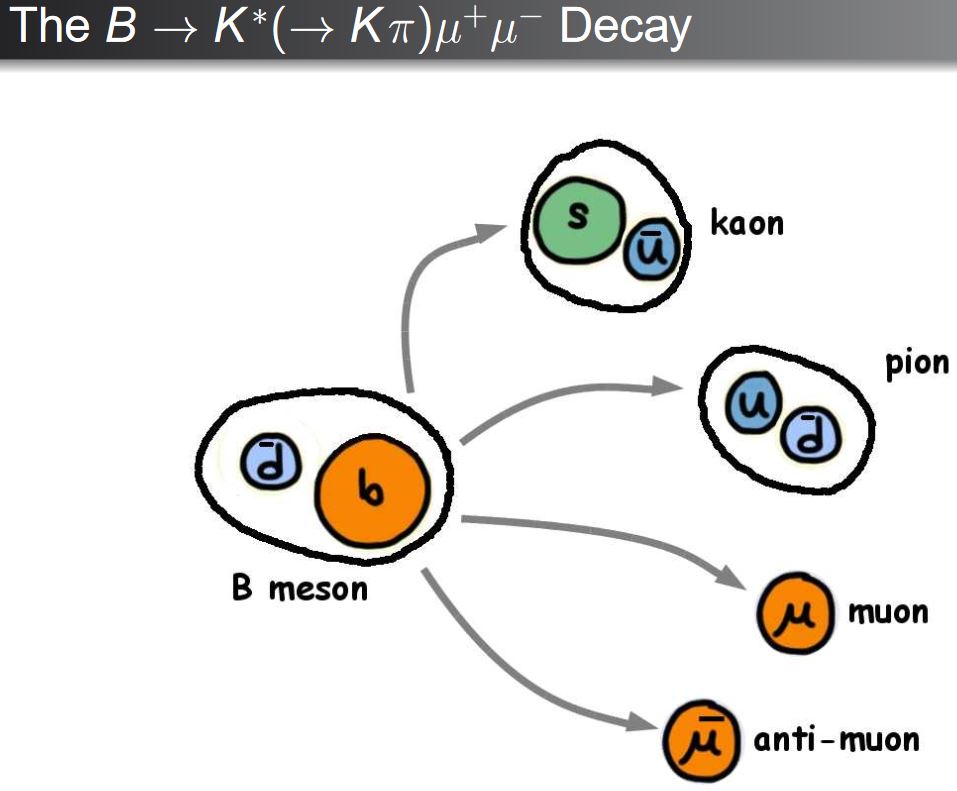
Hence flavour universality in the standard model of particle physics demands, for example, that the ratios of decay rates (branching fractions) of B-mesons into electrons are the same as into muons, hence that the ratio
(where is a kaon, a meson containing a strange quark)
is essentially equal to 1. Any significant departure of this observable from 1 would be a flavour anomaly and would mean that there are fundamental processes at play which are not described by the current standard model of particle physics (“New Physics”).
Moreover, in the standard model the decays involved here are “forbidden” (have vanishing decay rate) at tree level, so that only loop orders contribute to any possible flavour anomaly. But these loop contributions are sensitive to effects from putative undiscovered fundamental particles which “run in the loops” as virtual particles, and which thus may show up as a flavour anomaly even if their mass is too large for them to be seen as scattering products (i.e. as actual, non-virtual particles).
Finally, in forming the “branching” ratios (1) it is expected (see e.g. Nabeebaccus & Zwicky 2022) that “hadronic uncertainties cancel out”, namely that non-perturbative effects of QCD, which remain largely unknown (due to the open problem of confinement), contribute the same (unknown) factor to numerator and denominator and hence do not affect the ratio (Hiller & Krüger 2004, see also Isidori et al. 2021). Also QED-radiative corrections, while not cancelling out in this way, have been argued to be negligible (Bordone, Isidori and Pattori 2016, but see CFFPSSV 2021 for cautionary remarks). Therefore these branching ratios are regarded as “clean observables” in that their value, to relevant precision, is unambiguously predicted by the standard model of particle physics.
This way, tests of lepton flavour universality through measurement of branching ratios like (1) provide a means to potentially detect “New Physics” (effects not described by the present standard model) via indirect high-luminosity/high-precision experiment (see e.g. Brambilla et al. 2014, Section 5 AHRS 2020), complementary to traditional high-energy direct detection measurements.
Notice that the channel (1) is just one among the more prominent of several channels in which flavour anomalies may and have been seen. There are other decay channels of B-mesons such as with differing spectator quarks (LHCB 2021) and there are also flavour anomalies in decays of, for instance, kaons (Buras 16, Buras 2018) as well as in angular observables (LHCb 2020).
See Alonso 2019 for general introduction to an audience with basic background in quantum field theory.
Statistical significance
While the statistical significance of the flavour anomalies in every single decay channel is about - (around for some), the observations across channels are all compatible with each other, with a high joint/global statistical significance.
Alone, each notable B physics result is only a few-sigma discrepancy. But taken together, the aggregate of the results is—depending on whom you ask—a 5- to 7-sigma deviation from the standard model estimates.
and quoting Isodori:
“We’ve seen a lot of anomalies here and there popping up and going back, but this time I think it’s different… . For the first time, it’s not just one thing that doesn’t fit with the other, but it’s a coherent set of things.”
Moreover, there are other types of anomalies currently observed in the data (such as in the anomalous magnetic moment of the muon and in the mass of the W-boson) which have been argued to possibly have a joint origin with the anomalies in -meson decays (see below for more).
It is expected that if the ongoing evaluation of the data of LHC‘s Run 2 confirms the measurements of Run 1, then the statistical significance of the effect in each decay channel separately is expected to have reached 5 σ (Crivellin et. al 18, p. 12, Zupan 19, 4.6, in HMSN 21 this is expected for Run 3 data) and hence conventionally count as detection of flavour anomaly (see here), which would make it the first established “new physics” seen at the LHC. Extrapolation based on LHCb Collaboration 18 predicts a statistical significance between 6 and 10 by the year 2025 (LKLR 19, p. 12).
Up to 2019
Indications of flavour anomalies have been observed (first suggested in Hiller 2002, Koppenburg 2007, for introduction and review see Koppenburg 21) consistently and with increasing statistical significance around σ in B meson processes in various decay channels and by a number of independent experiments: the LHCb experiment, the Belle experiment and the BaBar experiment:
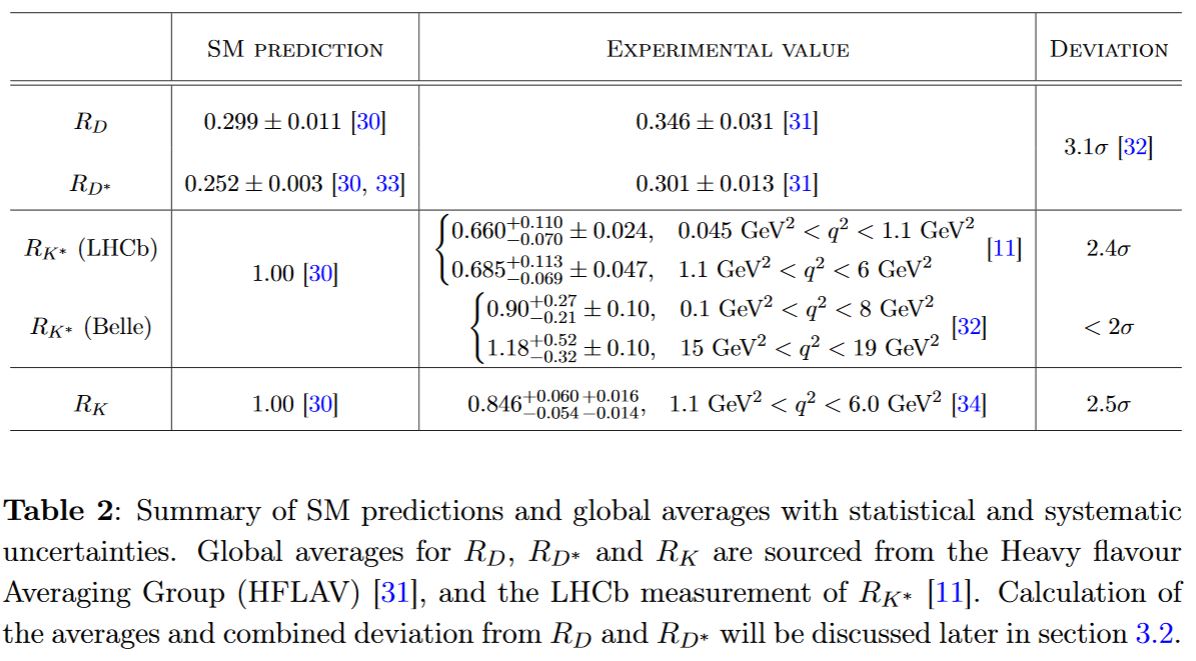
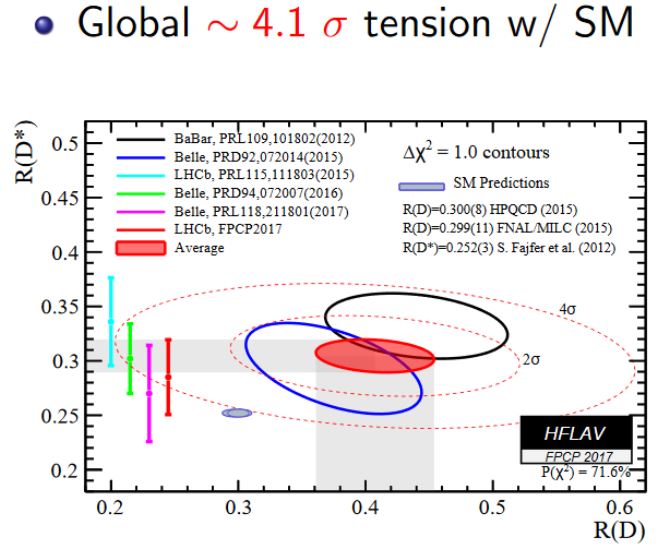
The global (all channels and experiments combined) tension with the standard model by end of 2018 had statistical significance around σ (Strumia et al. 17, Cartelle 18, slide 22/25, Dey 18, slide 16/23, HAMN 18, p. 4, Bouchard-Cao-Owen 19). Various authors see the global tension (i.e. of all decay channels jointly) at over (CCDGMV 17, CFMVV 17 CGMS 18, Dordei 18, slide 12), which traditionally qualifies as detection (see here), some authors already quote (ACDGMM 19) or (Kumar-London 19, Kumar 19).
More recent measurements in March 2021 make even just the combination of the particularly “clean” observables reach , see below for more recent references.
Updates in 2019
This situation was confirmed with the completed measurements presented at Moriond 2019, which showed (Straub 19, Allanach 19) smaller mean discrepancy but also had smaller uncertainty, thus keeping the statistical significance of the apparent anomaly essentially unaffected. But Caria 19, slide 9 reported new measurements by Belle (Belle 1910) according to which the previous statistical significance of in the channel would decrease to or (Gambino-Jung-Schacht 19 (6)). See LHCb 19, p. 2 for how the new numbers come about. The statistical significance over all sectors is still seen (London 19, p. 7) or (Jaiswal-Nandi-Patra 20). Moreover, the theoretical prediction is being corrected further away from these measured values (BDKL 20, footnote 1).
Comprehensive assessments of the situation after Moriond 2019 are given in AHMSN 19, Descotes-Genon 19, Bardhan-Ghosh 19, Alguero 19 and agree that the flavour anomalies have been confirmed:
It appears the reason is that, given the amount of independent measurements (~180!) a smaller deviation because of new physics is easier to accommodate than a large one. Thus the new measurements actually fit better with new physics.
(Axel Maas, reporting from ALPS2019, tweet, 23 Apr 2019)
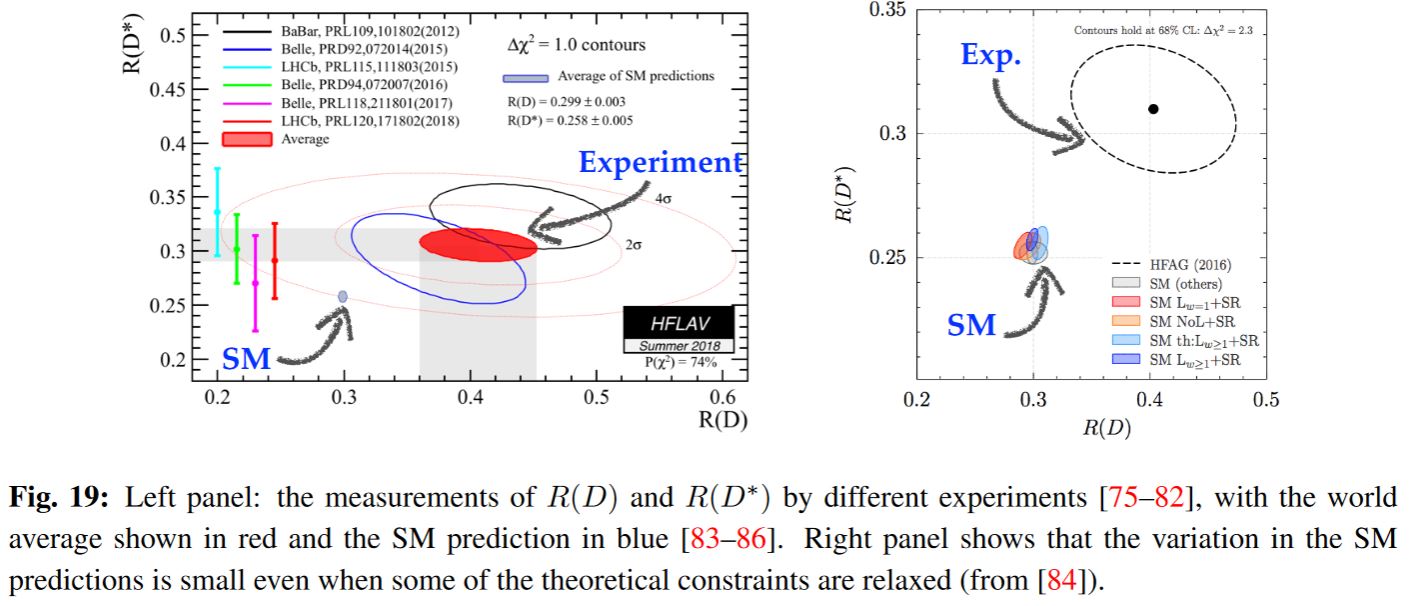
There is the claim (DGKV 19) that the discrepancy with the standard model increases further if non-trivial hadronic form factors are taken into account:


and also that the discrepancy increases further with QED-corrections taken into account (Mishra-Mahajan 20,p. 20-21).
Updates in 2020
Smith 20 on behalf of LHCb 2003.04831 (see also Lopes 20, CERN Courier 200311):
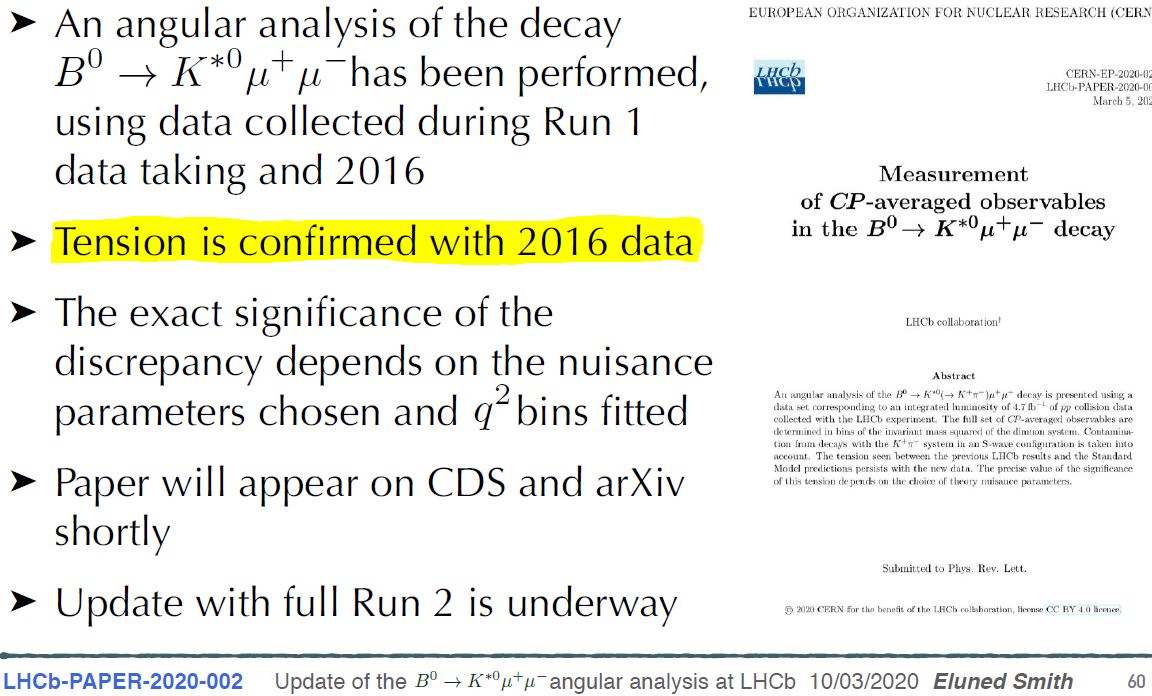
From Crivellin-Mueller-Saturnino 20a (where “LQ” is leptoquark):

Virto 21, p.6 points out (their emphasis):
Both and have moved towards the Standard Model, but this actually improves the New Physics fits. …
The set of anomalies are alive and a global coherence remains after the measurements in 2019 and 2020. While some key measurements have central values that have moved towards the Standard Model predictions, the overall consistency of the data and the global tension with respect to the Standard Model has not diminished (in fact this may even enhance the significance for New Physics). The New Physics fit is a good fit (with -values in the ballpark of 50%), and the SM pull is high …. In addition, data sets from all different experiments are compatible ….
The statistical significances of pull away from the standard model for effective New Physics models:
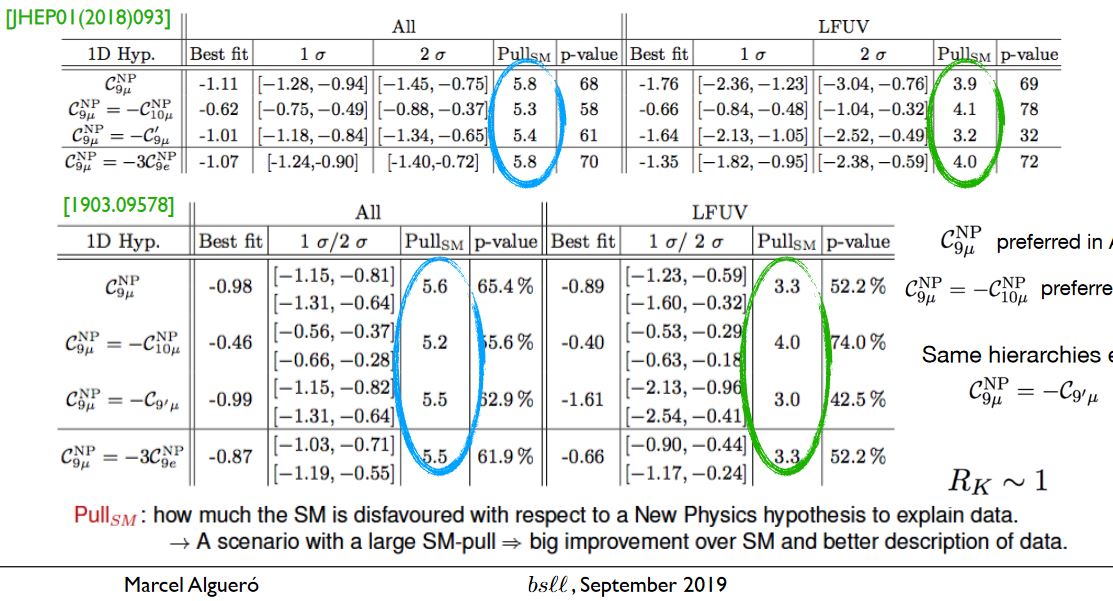

Updates in 2021
New measurements reported by LHC in March 2021 for the first time see deviation in a single decay channel at a statistical significance above .
Implications for the significance across channels:
Naive combination of and measurements shows a deviation from the standard model above
Motivated by LHCb’s new measurements we quantify the combined level of discrepancy with the Standard Model and fit values of short-distance Wilson coefficients. A combination of the clean observables , , and alone results in a discrepancy with the Standard Model at , up from in 2017. One-parameter scenarios with purely left-handed or with purely axial coupling to muons fit the data well and result in a pull from the Standard Model.
With the recent updates the case for new physics inrare B decays has been further strengthened. Even if only the theoretically clean LFU observables are considered, muon specific Wilson coefficients for New Physics improve over the Standard Model by .
With the recent result of LHCb , for the first time a single observable affected by negligible theoretical uncertainties exhibits a deviation from the SM exceeding the level. Equally striking is the overall coherence of the picture that emerges, especially in −transitions. As we shall show in this paper, combining all the −observables in a very conservative way, the significance of the New Physics (NP) hypothesis formulated in 2014–2015 of a purely left-handed LFU-violating contact interaction has now reached a significance of .
A more structural way of addressing the flavor structure of the model is the idea of implementing Pati-Salam unification
we obtain the global significance to be 3.9 standard deviations
the combined significance of the deviation reaches . Furthermore, taking into account also less theoretically-clean observables the overall significance of the deviations in this channel is raised to even above , depending on the specific SM prediction employed
A highly conservative method for combining the various anomalies, including the look-elsewhere effect, estimates their global significance to be 3.9σ. The combined set of discrepancies are by and large self-consistent with a common new physics origin involving muons.
From the global fits to various −data, the discrepancy is more than from the SM predictions. The new result (59) further strengthens the lepton flavor universality violation. This anomaly alone convincingly indicates New Physics
striking is the overall coherence of the picture that emerges, especially in −transitions. As we shall show in this paper, combining all the −observables in a very conservative way, the significance of the New Physics (NP) hypothesis formulated in 2014–2015 of a purely left-handed LFU-violating contact interaction has now reached a significance of .
Updates in 2022
We critically analyze the body of results that hints to the existence of New Physics from possible violations of lepton universality observed by the LHCb experiment. the deviations from the Standard Model are at the 4.7σ level when including only the hadronic insensitive observables while it increases to 6.1σ when including also the hadronic sensitive ones.
Scalar leptoquarks, either a singlet or a doublet of weak interactions, can explain all the anomalies.
when combining all tests of LFUV (like ) with decays involving muon pairs […], one finds a preference for new physics (NP) hypotheses of more than 7σ compared to the SM. Note that such a high significance is only possible since all measurements are compatible with each other, i.e. they form a coherent picture
We have used our improved scalar, vector and tensor form factors calculated in lattice QCD […] Our improved form factors significantly sharpen the tension, which becomes particularly strong in the region below the charmonium resonances. For we find a tension of 4.7σ for and 3.6σ for with LHCb ’14A and 3.3σ for with LHCb ’21
We present the first fully relativistic determination of the scalar, vector and tensor form factors for decays. […] Using these form factors, we can calculate the SM branching fraction for […] We find tensions above in the ratio of our result with LHCb, and above in one instance for the low bin.
The updated NP fits to rare B decays […] follow the same trend as with the previous set of results favouring in particular new physics contributions in the Wilson coefficient , with an increased significance. […] The projections for clean observables, show that if the current tensions remain, can establish NP with 5σ significance already with less than 20 of data. The main source of theory uncertainty in global fits is due to non-local hadronic contributions. However, different fits with different setups, inputs and statistical frameworks show a remarkable agreement so that the experimental observation of the discrepancy in these observables would be a clear sign of physics beyond the SM.
Incorporating several recent developments of determinations of the form factors in the Standard Model (SM), we observe a 4.1σ deviation from the SM predictions.
present data deviates from the SM predictions at 4.3σ.
For almost a decade now, there have been persistent indications from all three major B-facilities of lepton universality violations (LUV) [1], [2–10], with a combined significance of 4.5σ [11]. In tree-level charge current decays, B → D(∗)τ(l)ν, the reactions involving τ seem to differ more from those involving muon or electron than predicted by the SM. Another class of reaction that is presenting an even stronger indications of lepton flavor universality violations is flavor changing neutral current decays which, in the SM are loop-level. At the quark-lepton level this is b → sl+l − for l = µ or e. The corresponding ratios of such reactions, RK(∗) etc which in the SM are supposed to be unity within O(few %), experimentally at LHCb [9] are found to be significantly different from unity i.e. O(≈ 30%) at around 3 or even possibly ≈ 4σ. Moreover, another rather strong indication of new physics (NP) that has been strengthened this year is the muon (g-2) anomaly. For well over a decade this was already around 3.5σ being the difference between the experimental measurements at BNL from about 2002 [12] to around 2006 [13] and the theory predictions based on dispersion relations, data driven approach [14].
Recent confirmation by the Fermilab Collaboration [15] of the old BNL result has now increased the deviation from the data-driven theory prediction from the SM to about 4.2σ. The main point to bear in mind is that there are three anomalies, RD(∗) , RK(∗) and muon (g-2), and each of these is over three σ.
So, the chances of at least one of these surviving the test of time and leading us to new physics is rather high,
Fixing the backgrounds
However, LHCB22 claims that re-analysis of hadronic backgrounds in kaonic decays makes the decay rate in the electron channel go down, so that the ratio , over the corresponding muon channel is accurately described by the standard model (cf. A. Maas, 20 Dec 2022).
This seems to make all the apparent anomalies disappear.
we show that current data no longer provide strong hints for NP.
Relation to other anomalies
There is possibly a relation between the flavour anomalies to anomalies currently observed in other processes, notably to the anomalies observed in the anomalous magnetic moment of the electron and/or the muon (e.g. Chiang-Okada 17) which might point to a common origin in the flavour sector (e.g. Crivellin-Hoferichter 20):
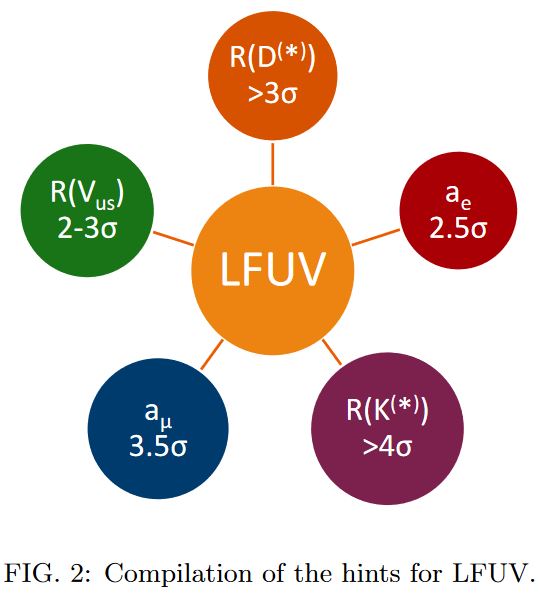
(here “” refers to flavour anomalies in various channels, “” refers to anomalies in the the anomalous magnetic moments of the electron and the muon, “LFUV” is shoft for “Lepton Flavor Universality Violation”, and the numbers are the statistical significances of the effects seen)
Indeed, leptoquark models preferred by the flavour anomalies (see below) are also a candidate explanation of the anomaly seen at over 4 statistical significance in the anomalous magnetic moment of the muon, see there.
Some authors therefore begin to speak jointly of muon anomalies (GST 21).
Here is a list of experiments, all somehow related to muons, which see deviations (shown in blue) from the theoretical expectation (shown in orange):
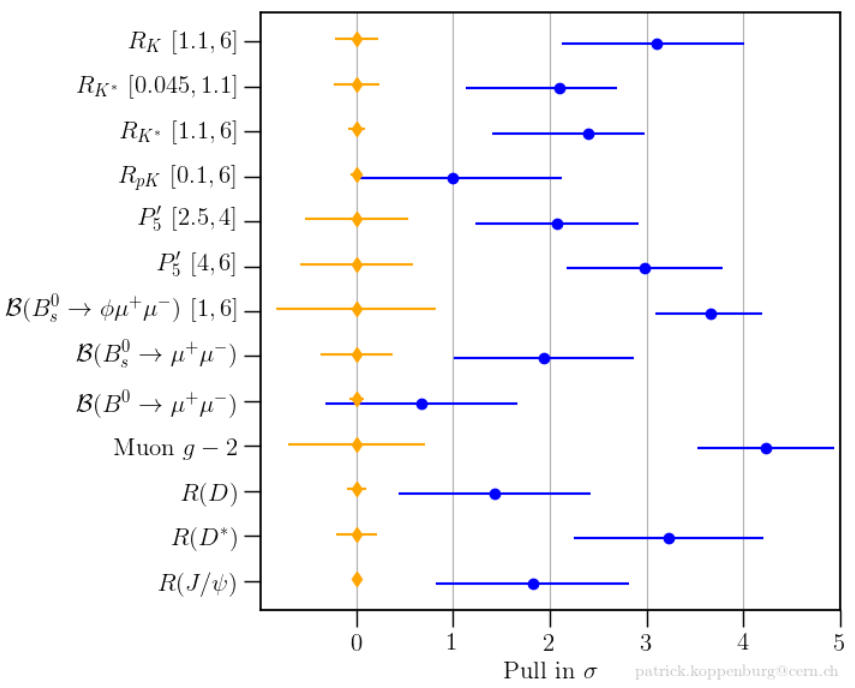
(This is as of April 2021, see here for the source text with more details; also Koppenburg 21, slide 44. For more data points and updates see Koppenburg Fl. Anom.)
A leptoquark-model meaning to explain all of the flavour anomalies, the (g-2)-anomaly and the Cabibbo anomaly at once: Marzocca-Trifinopoulos 21.
In ACMM22 it is argued (see footnote 3) that also the huge anomaly reported by CDF collaboration 2022 in the mass of the W-boson is compatible with (in fact predicted by) the -meson decay anomalies.
Status and Outlook
In conclusion, with currently available data, the observed flavour anomalies are possible signs of New Physics beyond the current standard model of particle physics.
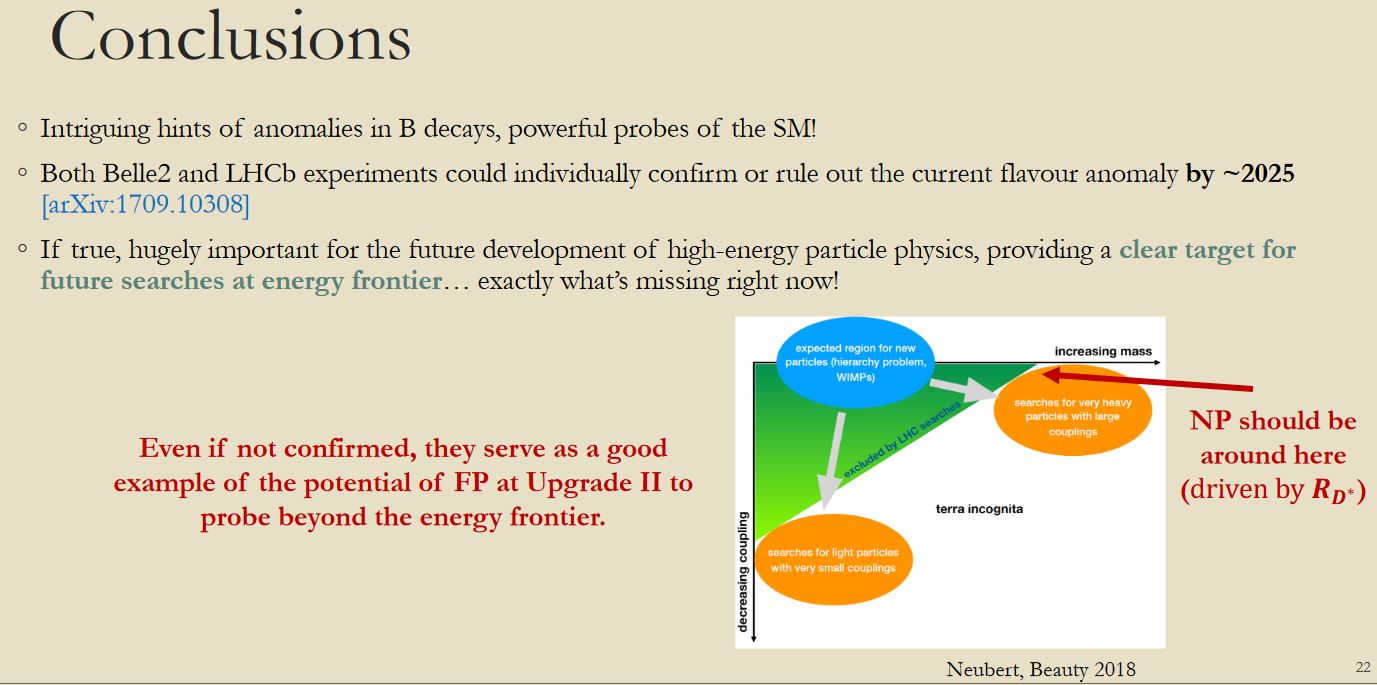
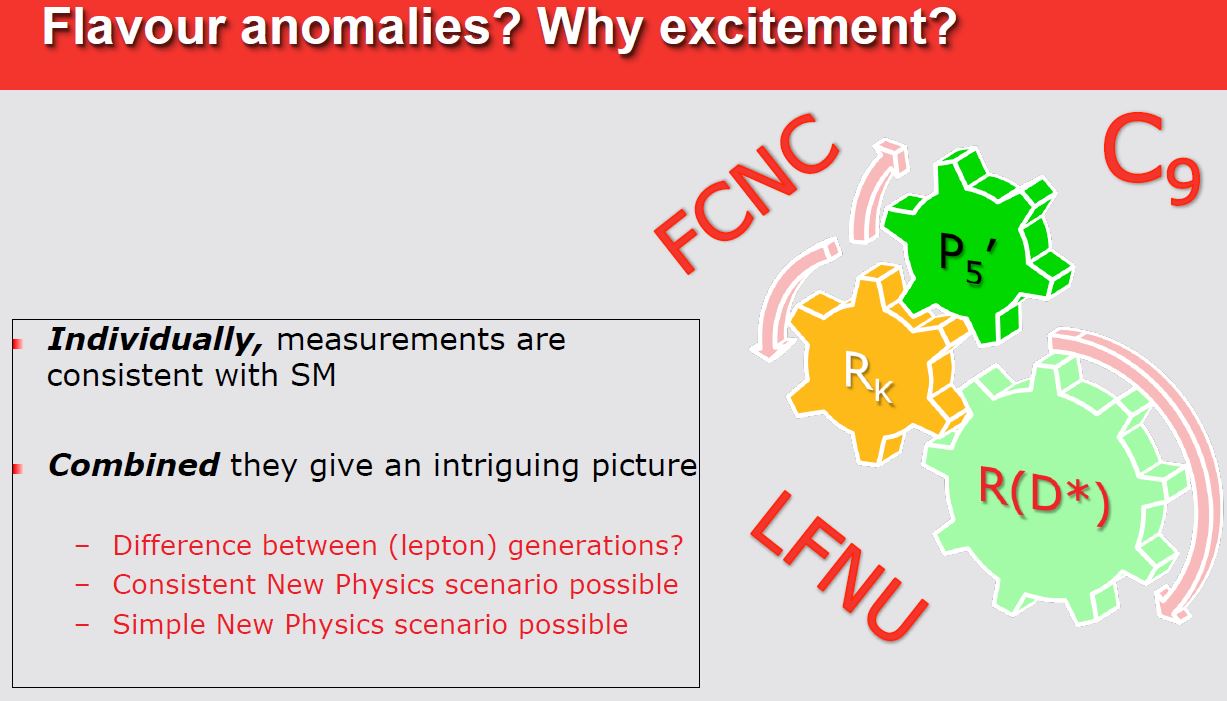
In any case, further and more sensitive experiments are needed to confirm and explore the effect, such as possibly the “HL-LHC” or “HE-LHC” experiment. General outlook, prospects and suggestions for future collider design in this respect are discussed in detail in Allanach-Gripaios-You 17, Crivellin et al. 18.
From Isidori 19, slide 6:
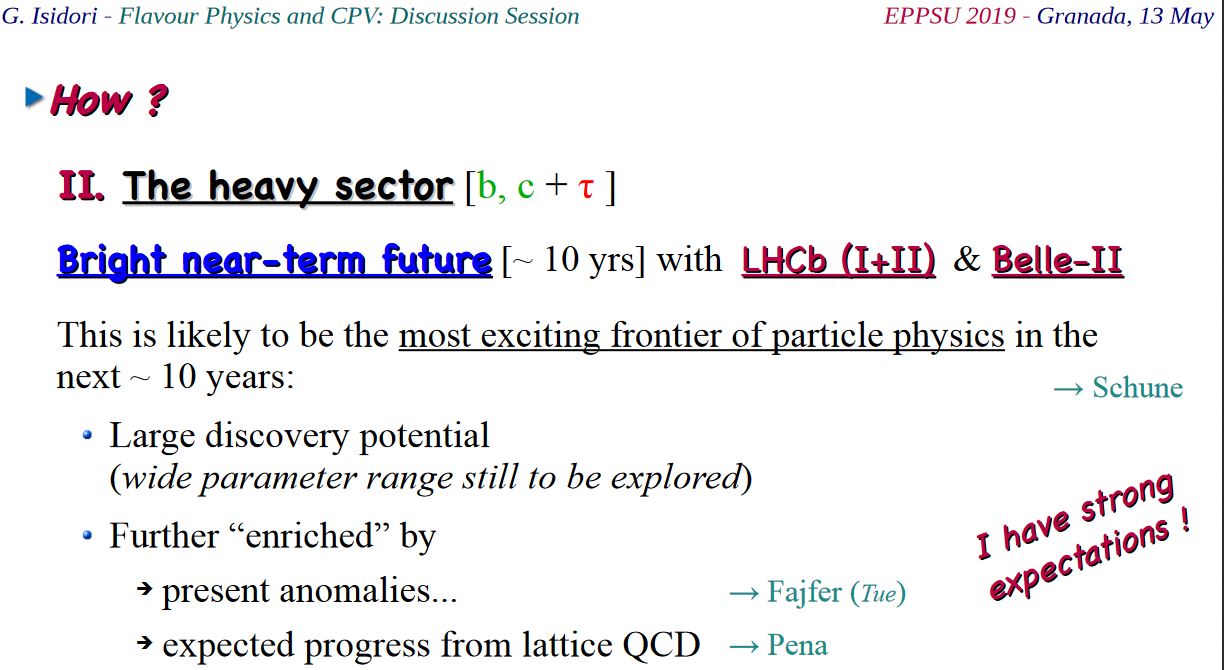
Outlook on the Belle II experiement to confirm the flavour anomalies, if real (HHJLQV 20):
With … Belle II, we are at the brink of a new era in quark flavour physics we present a phenomenological study of the potential for Belle II to reveal possible new physics in the inclusive decay channel
(p. 15:) We see that anomalies in the exclusive sector can be confirmed at the 5σ level by inclusive measurements if the true values of are at the current best-fit point of the exclusive fits
(p. 16:) After including , the reach in the plane improves considerably. Exclusive anomalies could be confirmed at the 6σ level.
(p. 20:) Should the true value of and be at the current best-fit points of the global fits, an analysis of inclusive at Belle II with of data will exclude the SM point at the level of σ. This again underlines the necessity of a full angular analysis of at Belle II.
From Guadagnoli & Koppenburg 2022:
The main final message is that all the instruments necessary to fully establish the putative new effects are at hand, thanks to running experiments and their upgrades. Therefore this subject stands concrete chances to usher genuinely unexpected discoveries.
Possible models
Candidate models of “New Physics” beyond the standard model of particle physics that could possibly explain the flavour anomalies (if indeed they are real) includes the following:
Leptoquarks and Grand unified theory
One promising model that could potentially explain the apparently observed flavour anomalies are leptoquarks, which naturally arise in, and hence potentially point to, grand unified theory (GUT) models, such as notably the Pati-Salam model (Heek-Teresi 18, Heek-Teresi 19)
(see Bauer-Neubert 15, CCDM 16, Crivellin 17, Falkowski17, Mueller 18, Matsuzaki-Nishiwaki 18, Monteux-Rajaraman 18, AMST 18, BDFKFS 18, Crivellin 18, MMR 18, Kumar-London 19, section 2.2.1, MVT 19, AMM 19, MVK 19, Cata-Mannel 19)
From Crivellin 18, p. 2:
the global fit to flavour anomalies even shows compelling evidence for New Physics … The vector leptoquark (LQ) singlet with hypercharge arising in the famous Pati-Salam model is capable of explaining all the flavour anomalies and therefore several attempts to construct a UV completion for this LQ to address the anomalies have been made. It can give a sizeable effect in data without violating bounds from and/or direct searches, provides (at tree level) a solution to data and does not lead to proton decay at any order in perturbation theory.
From GMV 20, Figure 9, showing fits of leptoquark models (labeled ) to a variety of observables:
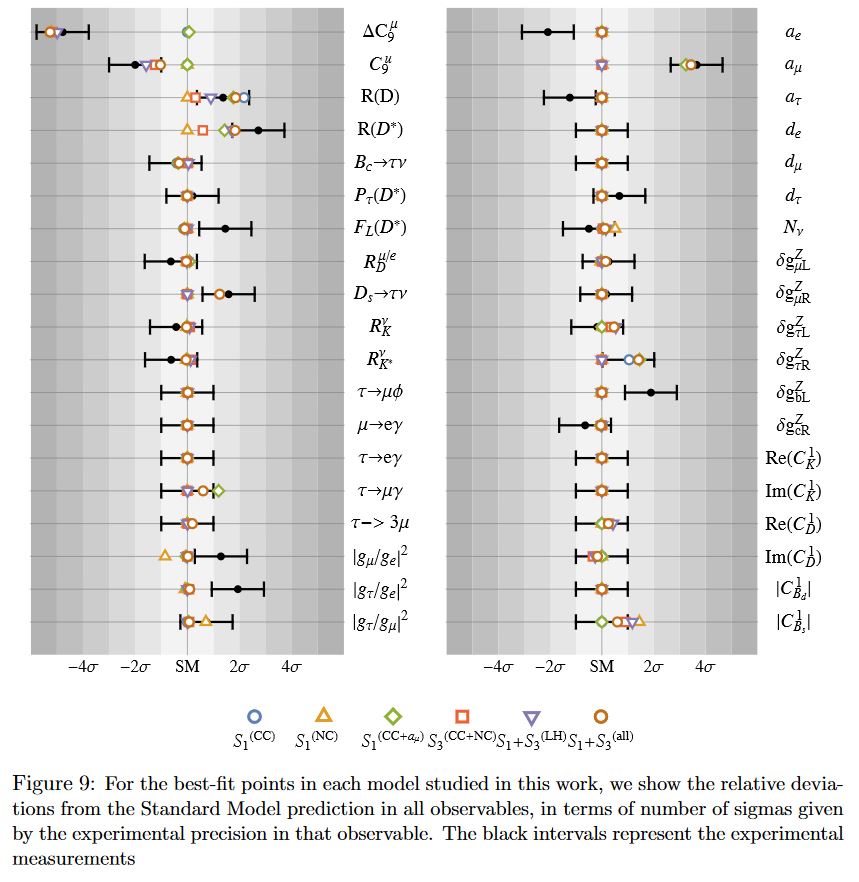
In CFFPV20:
In the Standard Model Effective Theory (SMEFT) [41, 42], the significance of NewPhysics from the global analysis increases with the inclusion of new data, reaching a maximum of almost 6σ for the simple hypothesis of a non-vanishing leptoquark contribution.
If it is a GUT-model containing the leptoquarks, then this seems to prefer embedding into a Randall-Sundrum model (Blanke & Crivellin 18, Crivellin 18) or similar (FMIPS21), hence a setup broadly as in intersecting D-brane models.
Other
Other possible models besides leptoquarks (above) which have been proposed as possible explanations of the apparently observed flavour anomalies include the following:
Related concepts
References
General
Early suggestion to look for New Physics in B-meson decays:
-
Gudrun Hiller, decays in and beyond the Standard Model, AIP Conf. Proc. 549:614-618, 2002 (arXiv:hep-ph/0008092)
-
Gudrun Hiller, Physics reach of rare b-decays, Nucl. Phys. Proc. Suppl. 115 (2003) 76-81 (arXiv:hep-ph/0207121)
-
Gudrun Hiller, Phenomenology of New Physics (arXiv:hep-ph/0308180)
and specifically concerning the LHCb-experiment
- Patrick Koppenburg, Selection of at LHCb and Sensitivity to , 2007 (cern:1027442, pdf)
On the branching ratios being “clean”, i.e. with small theoretic uncertainty:
early arguments:
- Gudrun Hiller, F. Krüger, More Model-Independent Analysis of Processes, Phys. Rev. D69 : 074020, 2004 (arXiv:hep-ph/0310219)
regarding QED-radiative corrections:
-
Marzia Bordone, Gino Isidori, Andrea Pattori, On the Standard Model predictions for and , Eur. Phys. J. C 76, 440 (2016). (arXiv:1605.07633, doi:10.1140/epjc/s10052-016-4274-7)
-
Gino Isidori, Saad Nabeebaccus, Roman Zwicky, QED Corrections in at the Double-Differential Level (arXiv:2009.00929)
comprehensive analysis:
- Gino Isidori, Davide Lancierini, Abhijit Mathad, Patrick Owen, Nicola Serra, Rafael Silva Coutinho, A general effective field theory description of lepton universality ratios (arXiv:2110.09882)
cautionary remarks:
- Marco Ciuchini, Marco Fedele, Enrico Franco, Ayan Paul, Luca Silvestrini, Mauro Valli, New Physics without bias: Charming Penguins and Lepton Universality Violation in decays (arXiv:2110.10126)
General introduction to the issue in B-meson decays:
-
Patrick Koppenburg, Zdenek Dolezal, Maria Smizanska, Rare decays of b hadrons, Scholarpedia, 11(6):32643 (doi:10.4249/scholarpedia.32643)
-
Simone Bifani, Sebastien Descotes-Genon, Antonio Romero Vidal, Marie-Helene Schune, Review of Lepton Universality tests in B decays, Journal of Physics G: Nuclear and Particle Physics, Volume 46, Number 2 (2018) (arXiv:1809.06229)
-
Rodrigo Alonso, Lepton (non-) unversality in (flavor changing) neutral current B decays, Proceedings of FPCP2019 (arXiv:1907.01716)
and for charm quark physics:
- Alexey Petrov, Theory of rare charm decays into leptons (arXiv:1704.03862)
Detailed introduction and survey as of May 2021;
- Patrick Koppenburg, Penguin B decays, 2021 (cds:2767155, pdf)
Up-to-date plots of observed anomalies:
- Patrick Koppenburg, Flavour Anomalies [anomalies.htlm]
Textbook account:
- Marina Artuso, Gino Isidori, Sheldon Stone, New Physics in Decays, World Scientific (2020) doi:10.1142/9789811251306
See also
-
CERN, LHCb flavour anomalies continue to intrigue, June 2017
-
Vasudevan Mukunth, A Similar Anomaly Has Showed up in Three Physics Experiments Since 2009. What’s Happening?, 2017
-
Diego Guadagnoli, On the status of flavor anomalies, 2016 (web)
Comprehensive overview of the latest world-averaged results to be found at:
-
Heavy Flavour Averaging group (HFLAV)
Brief review from the point of view of non-perturbative QCD:
- Brambilla et al., Section 5 of: QCD and strongly coupled gauge theories - challenges and perspectives, Eur Phys J C Part Fields. 2014; 74(10): 2981 (arXiv:1404.3723, doi:10.1140/epjc/s10052-014-2981-5)
On beingba “clean” observable with negligible theoretical error:
- Saad Nabeebaccus, Roman Zwicky, On the Theory Error [arXiv:2209.09585]
Experimental results
Before fixing the backgrounds
-
LHCb collaboration, Differential branching fractions and isospin asymmetries of decays, JHEP 06 (2014) 133 (arXiv:1403.8044)
-
LHCb collaboration, Test of lepton universality using decays, Phys. Rev. Lett. 113, 151601 (2014) (arXiv:1406.6482)
-
LHCb collaboration, Angular analysis and differential branching fraction of the decay , JHEP09(2015)179 (arXivL1506.08777)
-
LHCb collaboration, Differential branching fraction and angular analysis of decays, JHEP 06 (2015) 115; JHEP 09 (2018) 145 (arXiv:1503.07138)
-
LHCb collaboration, Test of lepton universality using decays, JHEP 08 (2017) 055 (arXiv:1705.05802)
-
LHCb collaboration, Measurement of the ratio of the and branching fractions using three-prong τ-lepton decays (arXiv:1708.08856)
-
Belle collaboration, Measurement of the lepton polarization and in the decay with one-prong hadronic τ decays at Belle (arXiv:1709.00129)
-
Belle collaboration, Measurement of the polarization in the decay (arXiv:1903.03102)
-
LHCb collaboration, Search for lepton-universality violation in decays (cern:2668514)
-
Belle Collaboration, Test of lepton flavor universality in decays at Belle (arXiv:1904.02440)
-
LHCb collaboration, Lepton flavour universality in charged-current decays (arXiv:1907.01500)
-
Belle collaboration, Measurement of and with a semileptonic tagging method, Phys. Rev. Lett. 124, 161803 (2020)
-
LHCb collaboration, Test of lepton universality with decays (arXiv:1912.08139)
also:
CERN courier, Debut for baryons in flavour puzzle, 20 Dec. 2019
CERN news, LHCb explores the beauty of lepton universality, 15 Jan 2020
(first measurement of lepton universality for Lambda baryons, finding the flavour anomaly at (only) 1 sigma but pointing in the same direction as seen in other channels)
-
LHCb collaboration, Measurement of CP-averaged observables in the decay, Phys. Rev. Lett. 125, 011802 (cds:2712641, arXiv:2003.04831, doi:10.1103/PhysRevLett.125.011802)
-
LHCb collaboration, Measurement of CP-averaged observables in the decay (spire:1784890, arXiv:2003.04831)
-
David Gerick on behalf of the LHCb collaboration, Rare Decays at LHCb: recent results, talk at Implications of LHCb measurements and future prospects, October 2020 (pdf)
-
LHCb collaboration, Angular analysis of the decay (arXiv:2012.13241)
-
LHCb collaboration, Tests of lepton universality using − and decays (arXiv:2110.09501)
-
Gregory Max Ciezarek on behalf of the LHCb collaboration: First joint measurement of and at LHCb, LHC seminar (2022) [indico:1187939, slides: pdf]
More accurate predictions from lattice QCD of the expected branching ratios:
-
W. G. Parrott, C. Bouchard, C. T. H. Davies, Standard Model predictions for , and using form factors from Nf=2+1+1 lattice QCD [arXiv:2207.13371]
-
W. G. Parrott, C. Bouchard, C. T. H. Davies, The search for new physics in and using precise lattice QCD form factors [arXiv:2210.10898]
After fixing the backgrounds
Announcement that hadronic backgrounds had been mis-identified all along and observation that fixing this makes at least the anomaly in disappear:
-
LHCb collaboration, Test of lepton universality in decays LHCb collaboration [arXiv:2212.09152]
LHCb collaboration, Measurement of lepton universality parameters in and decays [arXiv:2212.09153]
anonymous but informative Twitter thread on what happened: here
Davide Castelvecchi, Hint of crack in standard model vanishes in LHC data, Nature News (20 Dec 2022)
Re-analysis finding that thereby essentially all the anomalies disappear:
-
Marco Ciuchini, Marco Fedele, Enrico Franco, Ayan Paul, Luca Silvestrini, Mauro Valli, Constraints on Lepton Universality Violation from Rare B Decays [arXiv:2212.10516]
show that current data no longer provide strong hints for NP.
Review and outlook
-
Elena Graverini, Flavour anomalies: a review, in Proceedings of the 13th International Conference on Beauty, Charm and Hyperon hadrons (BEACH 2018) (arXiv:1807.11373)
-
Diego Guadagnoli, Flavour anomalies on the eve of the Run-2 verdict, Modern Physics Letters AVol. 32, No. 07, 1730006 (2017) (arXiv:1703.02804)
-
Greory Ciezarek, Manuel Franco Sevilla, Brian Hamilton, Robert Kowalewski, Thomas Kuhr, Vera Lüth, Yutaro Sato, A challenge to lepton universality in B-meson decays, Nature 546, 227–233 (2017) (doi:10.1038/nature22346)
-
CernCourier, Beauty quarks test lepton universality, March 2018
-
Paula Alvarez Cartelle on behalf of the LHCb collaboration, New results on flavor anomalies at LHCb, April 2018 (pdf)
-
Biplab Dey on behalf of the LHCb collaboration, Flavor anomalies at LHCb, May 2018 (pdf slides)
-
Vera Lüth, A Challenge to Lepton Universality in B Meson Decays, Invited tall at 7th Symposium on Symmetries in Subatomic Physics (SSP 2018) at RWTH Aachen University (Germany), June 11-15, 2018 (arXiv:1808.02587)
-
Francesca Dordei, Lepton flavour universality at LHCb, August 2018 (cern:2634813, pdf)
-
Karol Adamczyk (Belle collaboration), Semitauonic B decays at Belle/Belle II, Proceedings of the 10th International Workshop on the CKM Unitarity Triangle (CKM 2018), Heidelberg, Germany, September 17-21, 2018 (arXiv:1901.06380)
-
Christopher Bouchard, Lu Cao, Patrick Owen, Summary of the 2018 CKM working group on semileptonic and leptonic b-hadron decays (arXiv:1902.09412)
-
Jure Zupan, Introduction to flavour physics (arXiv:1903.05062)
-
David Straub on behalf of LHCb collaboration, Search for lepton-universality violation in decays, talk at Moriond 2019 (pdf)
-
Ben Allanach, Finding Z’s responsible for , talk at Moriond 2019 (pdf)
-
Sebastien Descotes-Genon, B-physics anomalies, fluctuations and patterns:a status report, talk at ALPS2019 (web, pdf)
-
Debjyoti Bardhan, Diptimoy Ghosh, B-meson charged current anomalies: the post-Moriond status (arXiv:1904.10432)
-
Marcel Alguero, Emerging patterns of New Physics with and without Lepton Flavour Universal contributions, talk at bsll2019 (pdf, pdf)
-
Jon Butterworth, Section 1 in: Highlights of EPS HEP 2019, talk at eps-hep2019 (arxiv:1910.12768)
-
Antonio Pich, Flavour Anomalies, PoS LHCP2019 (2019) 078 (arxiv:1911.06211, spire:1765034)
-
David London, Anomalies in B Decays: A Sign of New Physics?, talk at XIth International Symposium on Quantum Theory and Symmetries, July 1-5, 2018 Centre de recherches mathématiques, Montréal, Canada (arxiv:1911.06238)
-
Barbara Gallavotti, starring Gino Isidori, How Particle Physics Works: Episode II - The New Analysis, June 2019 (youtube)
-
Sneha Jaiswal, Soumitra Nandi, Sunando Kumar Patra, Updates on SM predictions of and in decays (arXiv:2002.05726)
-
Eluned Smith on behalf of the LHCb collaboration, Update of the angular analysis at LHCb, 2020 (pdf)
(on LHCb2003.04831)
-
Ana Lopes, New LHCb analysis still sees previous intriguing results, CERN News 2020
(on LHCb2003.04831)
-
CERN Courier, Anomalies persist in flavour-changing B decays, March 13 2020
(on LHCb2003.04831)
-
Patrick Koppenburg, Beauty 2019 – Conference summary (arXiv:2001.11796)
-
Javier Virto, Anomalies in transitions and Global Fits (arXiv:2103.01106)
-
Wolfgang Altmannshofer, Peter Stangl, New Physics in Rare B Decays after Moriond 2021 (arXiv:2103.13370)
-
Claudia Cornella, Darius A. Faroughy, Javier Fuentes-Martin, Gino Isidori, Matthias Neubert, Reading the footprints of the B-meson flavor anomalies (arXiv:2103.16558)
-
Davide Lancierini, Gino Isidori, Patrick Owen, Nicola Serra, On the significance of new physics in decays (arXiv:2104.05631)
-
T. Hurth, F. Mahmoudi, D. Martinez Santos, S. Neshatpour, More Indications for Lepton Nonuniversality in (arXiv:2104.10058)
-
Andreas Crivellin, Heavy Flavours – Theory, talk at LHCP, Paris 2021 (pdf)
-
Davide Lancierini, R. Dan Moise, Anomalous measurements: recent results deepen flavour puzzle, CERN EP Newsletter 21st June 2021 (arXiv:2107.06337)
-
Li-Sheng Geng, Benjamín Grinstein, Sebastian Jäger, Shuang-Yi Li, Jorge Martin Camalich, Rui-Xiang Shi, Implications of new evidence for lepton-universality violation in decays, Phys. Rev. D 104 (2021) 035029 (arXiv:2103.12738, doi:10.1103/PhysRevD.104.035029)
-
David London, Joaquim Matias, Flavour Anomalies: 2021 Theoretical Status Report (arXiv:2110.13270)
-
Valerio Gherardi, New Physics Hints from Flavour (arXiv:2111.00285)
-
Monika Blanke, Theory Perspective on Heavy Flavour Physics, talk at 10th Edition of the Large Hadron Collider Physics Conference (2022) [arXiv:2207.07354, talk slides and recording: indico.cern:4686945]
-
F. Mahmoudi, Theoretical Review of Rare B Decays [arXiv:2208.05755]
-
Syuhei Iguro, Teppei Kitahara, Ryoutaro Watanabe, Global fit to anomalies 2022 mid-autumn [arXiv:2210.10751]
-
Ashutosh Kotwal, Joaquim Matias, Andrea Mauri, Tom Tong, Lukas Varnhorst, Round table on Standard Model Anomalies [arXiv:2211.13030]
Further outlook:
-
Ben Allanach, Ben Gripaios, Tevong You, The Case for Future Hadron Colliders From Decays, JHEP03(2018)021 (arXiv:1710.06363)
-
LHCb collaboration, Physics case for an LHCb Upgrade II - Opportunities in flavour physics, and beyond, in the HL-LHC era (arXiv:1808.08865)
-
A. Cerri, Andreas Crivellin et. al. Opportunities in Flavour Physics at the HL-LHC and HE-LHC, Report from Working Group 4 on the Physics of the HL-LHC, and Perspectives at the HE-LHC (arXiv:1812.07638)
-
Gino Isidori, Hints of New Physics from flavor-changing processes, talk at SPS Annual Meeting, Lausanne, Aug. 2018 (pdf)
-
Gino Isidori, Flavor physics & CP violation, talk at Symposium on the European Strategy for Particle Physics 2019 (pdf)
-
Luca Di Luzio, Matthew Kirk, Alexander Lenz, Thomas Rauh, theory precision confronts flavour anomalies (arXiv:1909.11087)
-
Benjamin Grinstein, A path to flavor, talk at Implications of LHCb measurement and future prospects CERN 2019 (pdf, pdf, indico:3582540)
-
Monika Blanke, Flavour Physics from Present to Future Colliders, talk at LFC19: Strong dynamics for physics within and beyond the Standard Model at LHC and Future Colliders (2019) (arxiv:1910.10662)
-
Andreas Crivellin, Martin Hoferichter, Beta decays as sensitive probes of lepton flavor universality (arXiv:2002.07184)
-
Dan Garisto, The Era of Anomalies, Physics 13, 79 (2020)
-
Niels Tuning, Recent results from LHCb, Nikhef 2020 (nikhef event:2253, pdf, pdf)
In recent years a number of results in flavour physics have drawn some attention due to tensions with respect to Standard Model predictions. An overview of these results will be shown, together with a few recent results from this Spring, both on the flavour anomalies and ‘classical’ flavour physics
-
Florian U. Bernlochner, Manuel Franco Sevilla, Dean J. Robinson, Guy Wormser, Semitauonic b-hadron decays: A lepton flavor universality laboratory (arXiv:2101.08326)
-
Li-Sheng Geng, Benjamín Grinstein, Sebastian Jäger, Shuang-Yi Li, Jorge Martin Camalich, Rui-Xiang Shi, Implications of new evidence for lepton-universality violation in decays (arXiv:2103.12738)
-
Riccardo Barbieri, Section 5 of: A view of flavour physics in 2021 (arXiv:2103.15635)
-
Diego Guadagnoli, Patrick Koppenburg, Lepton-flavor violation and lepton-flavor-universality violation in b and c decays [arXiv:2207.01851]
-
Amarjit Soni, Precision tau physics: Challenge for Theory, on and off the lattice [arXiv:2211.05839]
Outlook for Belle II to confirm the flavour anomalies, if they are real:
- Tobias Huber, Tobias Hurth, Jack Jenkins, Enrico Lunghi, Qin Qin, K.Keri Vos, Phenomenology of inclusive for the Belle II era (arXiv:2007.04191)
Emphasis of non-perturbative effects:
-
Ulrich Nierste, Flavour Anomalies: Phenomenology and BSM Interpretations, talk at Planck 2018, Bonn 2018 (pdf)
-
Saeed Kamali, New physics in inclusive semileptonic decays including nonperturbative corrections (arXiv:1811.07393)
Emphasis of higher loop order-effects:
- Andreas Crivellin, Christoph Greub, Dario Müller, Francesco Saturnino, Importance of Loop Effects in Explaining the Accumulated Evidence for New Physics in B Decays with a Vector Leptoquark, Phys. Rev. Lett. 122, 011805 (2019) (arXiv:1807.02068)
Emphasis of effects of hadronic form factors:
-
Sébastien Descotes-Genon, Alexander Khodjamirian, Javier Virto, Light-Cone Sum Rules for Form Factors and Applications to Rare Decays (arXiv:1908.02267)
-
Sebastien Descotes-Genon, Light-cone sum rules for form factorsand applications to rare decays, talk at bsll2019 (pdf, pdf)
Emphasis of QED-corrections:
- Dayanand Mishra, Namit Mahajan On the Impact of Soft Photons on (arXiv:2010.10853)
Textbook account:
- Andrzej Buras, Gauge Theory of Weak Decays, (2020) (doi:10.1017/9781139524100, CERN review by Gino Isidori)
Original articles:
-
Guido D’Amico, Marco Nardecchia, Paolo Panci, Francesco Sannino, Alessandro Strumia, Riccardo Torre, Alfredo Urbano,
Flavour anomalies after the measurement,
J. High Energ. Phys. (2017) 2017 (arXiv:1704.05438)
-
Andrea Mauri, Nicola Serra, Rafael Silva Coutinho, Towards establishing Lepton Flavour Universality violation in decays (arXiv:1805.06401)
-
Bernat Capdevila, Andreas Crivellin, Sébastien Descotes-Genon, Joaquim Matias, Javier Virto, Patterns of New Physics in transitions in the light of recent data, JHEP 1801 (2018) 093 (arXiv:1704.05340)
-
Alejandro Celis, Javier Fuentes-Martin, Avelino Vicente, Javier Virto, Gauge-invariant implications of the LHCb measurements on Lepton-Flavour Non-Universality, Phys. Rev. D 96, 035026 (2017) (arXiv:1704.05672)
-
Monika Blanke, Andreas Crivellin, Stefan de Boer, Teppei Kitahara, Marta Moscati, Ulrich Nierste, Ivan Nišandžić, Impact of polarization observables and on new physics explanations of the anomaly (arXiv:1811.09603)
-
Monika Blanke, Andreas Crivellin, Stefan de Boer, Teppei Kitahara, Marta Moscati, Ulrich Nierste, Ivan Nišandžić, Addendum: “Impact of polarization observables and on new physics explanations of the anomaly” (arXiv:1905.08253)
-
Jacky Kumar, David London, New physics in ?, Phys. Rev. D 99, 073008 (2019) (arXiv:1901.04516, doi:10.1103/PhysRevD.99.073008)
-
Domagoj Leljak, Blazenka Melic, Monalisa Patra, On lepton flavour universality in semileptonic decays (arXiv:1901.08368)
-
Rui-Xiang Shi, Li-Sheng Geng, Benjamín Grinstein, Sebastian Jäger, Jorge Martin Camalich, Revisiting the new-physics interpretation of the data (arXiv:1905.08498)
Cautionary remarks include
-
Giacomo Caria on behalf of the Belle collaboration, Measurement of and with a semileptonic tag at Belle, Moriond, EW 22/03/2019 (pdf)
In contrast, an argument that the threshold statistical significance for flavour anomalies should be taken to be instead of is made in
-
Louis Lyons, Discovering the Significance of 5 sigma (arXiv:1310.1284)
-
Tommaso Dorigo, Extraordinary claims: the solution, EPJ Web of Conferences 95, 02003 (2015) (doi:10.1051/epjconf/20159502003)
Discussion of possible anomalies:
- Aleksey V. Rusov, Probing New Physics in Transitions (arXiv:1911.12819)
In hadronic decays
-
Marzia Bordone, Nico Gubernari, Tobias Huber, Martin Jung, Danny van Dyk, A puzzle in B¯0(s)→D+(s){π−,K−} decays and extraction of the fs/fd fragmentation fraction (arXiv:2007.10338)
-
Syuhei Iguro, Teppei Kitahara, Implications for new physics from novel puzzle in B¯0(s)→D(∗)+(s){π−,K−} decays (arXiv:2008.01086)
-
Eleftheria Malami, Exploring New Physics in B→πK Decays (arXiv:2008.08468)
Relation to -anomalies
Beyond their possible common origin in leptoquarks, further possible joint explanation of flavour anomalies and the anomalies observed in the muon anomalous magnetic moment:
-
Geneviève Bélanger, Cédric Delaunay, Susanne Westhoff, A Dark Matter Relic From Muon Anomalies, Phys. Rev. D 92, 055021 (2015) (arXiv:1507.06660)
-
Cheng-Wei Chiang, Hiroshi Okada, A simple model for explaining muon-related anomalies and dark matter (arXiv:1711.07365)
-
Junichiro Kawamura, Stuart Raby, Andreas Trautner, Complete Vector-like Fourth Family and new for Muon Anomalies (arXiv:1906.11297)
-
Lorenzo Calibbi, M.L. López-Ibáñez, Aurora Melis, Oscar Vives, Muon and electron and lepton masses in flavor models (arXiv:2003.06633)
-
A. S. de Jesus, S. Kovalenko, F. S. Queiroz, K. Sinha, C. Siqueira, Vector-Like Leptons and Inert Scalar Triplet: Lepton Flavor Violation, and Collider Searches (arXiv:2004.01200)
-
Shaikh Saad, Combined explanations of , , anomalies in a two-loop radiative neutrino mass model (arXiv:2005.04352)
-
K. S. Babu, P. S. Bhupal Dev, Sudip Jana, Anil Thapa, Unified Framework for -Anomalies, Muon , and Neutrino Masses (arXiv:2009.01771)
-
Sang Quang Dinh, Hieu Minh Tran, Muon and semileptonic decays in BDW model with gauge kinetic mixing (arXiv:2011.07182)
Possible explanations/models
General EFT parameterization
General effective field theory parametrization:
-
T. Hurth, A. Arbey, F. Mahmoudi, S. Neshatpour, New global fits to data with all relevant parameters, Proceedings of the Seventh Workshop on Theory, Phenomenology and Experiments in Flavour Physics, Capri, 8-10 June 2018 (arXiv:1812.07602)
-
Srimoy Bhattacharya, Aritra Biswas, Zaineb Calcuttawala, Sunando Kumar Patra, An in-depth analysis of semileptonic observables with possible mixing (arXiv:1902.02796)
-
Marcel Algueró, Bernat Capdevila, Sébastien Descotes-Genon, Pere Masjuan, Joaquim Matias, What and can tell us about New Physics in transitions? (arXiv:1902.04900)
-
Marcel Algueró, Bernat Capdevila, Andreas Crivellin, Sébastien Descotes-Genon, Pere Masjuan, Joaquim Matias, Javier Virto, Addendum: “Patterns of New Physics in transitions in the light of recent data” (arXiv:1903.09578)
-
Ashutosh Kumar Alok, Amol Dighe, Shireen Gangal, Dinesh Kumar, Continuing search for new physics in decays: two operators at a time (arXiv:1903.09617)
-
Marco Ciuchini, António M. Coutinho, Marco Fedele, Enrico Franco, Ayan Paul, Luca Silvestrini, Mauro Valli, New Physics in confronts new data on Lepton Universality (arXiv:1903.09632)
-
Jason Aebischer, Wolfgang Altmannshofer, Diego Guadagnoli, Meril Reboud, Peter Stangl, David M. Straub, B-decay discrepancies after Moriond 2019 (arXiv:1903.10434)
-
Alakabha Datta, Jacky Kumar, David London, The Anomalies and New Physics in (arXiv:1903.10086)
-
Ashutosh Kumar Alok, Dinesh Kumar, Suman Kumbhakar, S Uma Sankar, Impact of polarization measurement on solutions to - anomalies (arXiv:1903.10486)
-
Pere Arnan, Andreas Crivellin, Marco Fedele, Federico Mescia, Generic Loop Effects of New Scalars and Fermions in and a Vector-like 4th Generation (arXiv:1904.05890)
-
A. Arbey, T. Hurth, F. Mahmoudi, D. Martinez Santos, S. Neshatpour, Update on the anomalies (arXiv:1904.08399)
-
Pouya Asadi, David Shih, Maximizing the Impact of New Physics in Anomalies, (arXiv:1905.03311)
-
J. E. Chavez-Saab, Marxil Sánchez, Genaro Toledo, or : closing the theoretical gap? (arXiv:1905.03394)
-
Suman Kumbhakar, Ashutosh Kumar Alok, Dinesh Kumar, S Uma Sankar, Resolving and anomalies (arXiv:1905.03513)
-
Jyoti Saini, Dinesh Kumar, Shireen Gangal, S. B. Dasm, Probing signatures of beyond standard model physics through decay (arXiv:1905.03933)
-
David London, CP Violation in (arXiv:1906.07752)
-
Marta Moscati, New Physics in : Impact of Polarisation Observables and (arXiv:1906.08035)
-
Damir Becirevic, Marco Fedele, Ivan Nisandzic, Andrey Tayduganov, Lepton Flavor Universality tests through angular observables of decay modes (arXiv:1907.02257)
-
Ashutosh Kumar Alok, Suman Kumbhakar, S. Uma Sankar, Discriminating new physics scenarios in b→sμ+μ− via transverse polarization asymmetry of K∗ in B→K∗μ+μ− decay (arXiv:2001.04395)
-
Suman Kumbhakar, Ashutosh Kumar Alok, Dinesh Kumar, S. Uma Sankar, New Physics solutions for anomalies after Moriond 2019 (arXiv:2001.06344)
-
Florian U. Bernlochner, Stephan Duell, Zoltan Ligeti, Michele Papucci, Dean J. Robinson, Das ist der HAMMER: Consistent new physics interpretations of semileptonic decays (arXiv:2002.00020)
-
Andrei Angelescu, Darius A. Faroughy, Olcyr Sumensari, Lepton Flavor Violation and Dilepton Tails at the LHC (arXiv:2002.05684)
-
Kingman Cheung, Zhuo-Ran Huang, Hua-Dong Li, Cai-Dian Lü, Ying-nan Mao, Ru-Ying Tang, Revisit to the transition: in and beyond the SM (arXiv:2002.07272)
-
Soumia Lebbal, Noureddine Mebarki, Jamal Mimouni, Lepton Flavor Universality Violation in a 331 Model in Processes (arXiv:2003.03230)
-
Rafael Aoude, Tobias Hurth, Sophie Renner, William Shepherd, The impact of flavour data on global fits of the MFV SMEFT (arXiv:2003.05432)
-
Aritra Biswas, Soumitra Nandi, Ipsita Ray, Sunando Kumar Patra, New physics in decays with complex Wilson coefficients (arXiv:2004.14687)
-
Bhubanjyoti Bhattacharya, Alakabha Datta, Saeed Kamali, David London, A Measurable Angular Distribution for Decays (arXiv:2005.03032)
-
N. Penalva, E. Hernández, J. Nieves, , and semileptonic decays including new physics (arXiv:2007.12590)
-
Aishwarya Bhatta, Rukmani Mohanta, Implications of new physics in −decay processes (arXiv:2011.05820)
-
S. Neshatpour, T. Hurth, F. Mahmoudi, Searching for New Physics with (arXiv:2012.07408)
In relation to electroweak precision measurements:
-
Lina Alasfar, Aleksandr Azatov, Jorge de Blas, Ayan Paul, Mauro Valli, B anomalies under the lens of electroweak precision (arXiv:2007.04400)
-
Ashutosh Kumar Alok, Suman Kumbhakar, Jyoti Saini, S Uma Sankar, New physics in : A model independent analysis (arXiv:2011.14668)
-
T. Hurth, F. Mahmoudi, S. Neshatpour, Model independent analysis of the angular observables in B0→K∗0μ+μ− and B+→K∗+μ+μ− (arXiv:2012.12207)
-
Jorge Alda, Jaume Guasch, Siannah Penaranda, Anomalies in B mesons decays: A phenomenological approach (arXiv:2012.14799)
-
Jorge Alda, Jaume Guasch, Siannah Penaranda, Anomalies in B mesons decays: Present status and future collider prospects (arXiv:2105.05095)
Leptoquarks
explanation via assumption of leptoquarks:
-
Martin Bauer, Matthias Neubert, One Leptoquark to Rule Them All: A Minimal Explanation for , and , Phys. Rev. Lett. 116, 141802 (2016) (arXiv:1511.01900)
-
Yi Cai, John Gargalionis, Michael A. Schmidt, Raymond R. Volkas, Reconsidering the One Leptoquark solution: flavor anomalies and neutrino mass (arXiv:1704.05849)
-
Estefania Coluccio Leskow, Andreas Crivellin, Giancarlo D’Ambrosio, Dario Müller, , Lepton Flavour Violation and Z Decays with Leptoquarks: Correlations and Future Prospects, Phys. Rev. D 95, 055018 (2017) (arXiv:1612.06858)
-
Andreas Crivellin, New Physics in Flavour Observables (arXiv:1706.00929)
-
Adam Falkowski, Leptoquarks strike back, November 2017
-
Dario Müller, Leptoquarks in Flavour Physics, EPJ Web of Conferences 179, 01015 (2018) (arXiv:1801.03380)
-
Shinya Matsuzaki, Kenji Nishiwaki, Kei Yamamoto, Simultaneous interpretation of K and B anomalies in terms of chiral-flavorful vectors (arXiv:1806.02312)
-
Angelo Monteux, Arvind Rajaraman, B Anomalies and Leptoquarks at the LHC: Beyond the Lepton-Quark Final State, Phys. Rev. D 98, 115032 (2018) (arXiv:1803.05962)
-
Ufuk Aydemir, Djordje Minic, Chen Sun, Tatsu Takeuchi, -decay anomalies and scalar leptoquarks in unified Pati-Salam models from noncommutative geometry, JHEP 09 (2018) 117 (arXiv:1804.05844)
-
Damir Bečirević, Ilja Doršner, Svjetlana Fajfer, Nejc Košnik, Darius A. Faroughy, Olcyr Sumensari, Scalar leptoquarks from GUT to accommodate the -physics anomalies, Phys. Rev. D 98, 055003 (2018) (arXiv:1806.05689)
-
Jacky Kumar, David London, Ryoutaro Watanabe, Combined Explanations of the and Anomalies: a General Model Analysis, Phys. Rev. D 99, 015007 (2019) (arXiv:1806.07403)
(reviewed in Kumar 19)
-
Tanumoy Mandal, Subhadip Mitra, Swapnil Raz, in minimal leptoquark scenarios: impact of interference on the exclusion limits from LHC data (arXiv:1811.03561)
-
Jason Aebischer, Andreas Crivellin, Christoph Greub, QCD Improved Matching for Semi-Leptonic B Decays with Leptoquarks (arXiv:1811.08907)
-
Michael J. Baker, Javier Fuentes-Martin, Gino Isidori, Matthias König, High-pT Signatures in Vector-Leptoquark Models (arXiv:1901.10480)
-
Ivo de Medeiros Varzielas, Jim Talbert, Simplified Models of Flavourful Leptoquarks (arXiv:1901.10484)
-
Natascia Vignaroli, Seeking leptoquarks in the plus missing energy channel at the high-luminosity LHC (arXiv:1808.10309)
-
Ufuk Aydemir, Tanumoy Mandal, Subhadip Mitra, Addressing the anomalies with an S1 leptoquark from grand unification, Phys. Rev. D 101, 015011 (2020) (arXiv:1902.08108)
-
Ivo de Medeiros Varzielas, Stephen F. King, Origin of Yukawa couplings for Higgs and leptoquarks (arXiv:1902.09266)
-
Oscar Cata, Thomas Mannel, Linking lepton number violation with anomalies (arXiv:1903.01799)
-
Bhubanjyoti Bhattacharya, Alakabha Datta, Saeed Kamali, David London, CP Violation in (arXiv:1903.02567)
-
Han Yan, Ya-Dong Yang, Xing-Bo Yuan, Phenomenology of decays in a scalar leptoquark model (arXiv:1905.01795)
-
Alakabha Datta, Divya Sachdeva, John Waite, A unified explanation of anomalies, neutrino masses and puzzle (arXiv:1905.04046)
-
Andrei Angelescu, Single Leptoquark Solutions to the -physics Anomalies, contribution to the 2019 EW session of the 54th Rencontres de Moriond (arXiv:1905.06044)
-
Oleg Popov, Michael A. Schmidt, Graham White, as a single leptoquark solution to and (arXiv:1905.06339)
-
Andreas Crivellin, Francesco Saturnino, Correlating Tauonic B Decays to the Neutron EDM via a Scalar Leptoquark (arXiv:1905.08257)
-
Andreas Crivellin, Francesco Saturnino, Explaining the Flavor Anomalies with a Vector Leptoquark (Moriond 2019 update) (arXiv:1906.01222)
-
Innes Bigaran, John Gargalionis, Raymond R. Volkas, A near-minimal leptoquark model for reconciling flavour anomalies and generating radiative neutrino masses (arXiv:1906.01870)
-
Michal Malinský, Lepton non-universality in -decays in the minimal leptoquark gauge model (arXiv:1906.09174)
-
Jordan Bernigaud, Ivo de Medeiros Varzielas, Jim Talbert, Finite Family Groups for Fermionic and Leptoquark Mixing Patterns (arXiv:1906.11270)
-
Junichiro Kawamura, Stuart Raby, Andreas Trautner, Complete Vector-like Fourth Family and new for Muon Anomalies (arXiv:1906.11297)
-
Leandro Da Rold, Federico Lamagna, A vector leptoquark for the B-physics anomalies from a composite GUT (arXiv:1906.11666)
-
Jacky Kumar, Combined explanation of the B-anomalies, Proceedings for FPCP 2019 (arXiv:1907.00416)
(review of KumarLondonWatanabe18)
-
C. Hati, J. Kriewald, J. Orloff, A.M. Teixeira, A nonunitary interpretation for a single vector leptoquark combined explanation to the B-decay anomalies (arXiv:1907.05511)
-
Javier Fuentes-Martin, Gino Isidori, Matthias König, Nudzeim Selimovic, Vector Leptoquarks Beyond Tree Level (arxiv:1910.13474)
-
Shaikh Saad, Anil Thapa, A Common Origin of Neutrino Masses and , Anomalies (arXiv:2004.07880)
-
P. S. Bhupal Dev, Rukmani Mohanta, Sudhanwa Patra, Suchismita Sahoo, Unified explanation of flavor anomalies, radiative neutrino mass and ANITA anomalous events in a vector leptoquark model (arXiv:2004.09464)
-
Suman Kumbhakar, Rukmani Mohanta, Investigating the effect of vector leptoquark on mediated B decays (arXiv:2008.04016)
-
Valerio Gherardi, David Marzocca, Elena Venturini, Low-energy phenomenology of scalar leptoquarks at one-loop accuracy (arXiv:2008.09548)
-
Andreas Crivellin, Dario Mueller, Francesco Saturnino, Leptoquarks in Oblique Corrections and Higgs Signal Strength: Status and Prospects (arXiv:2006.10758)
-
Marco Ciuchini, Marco Fedele, Enrico Franco, Ayan Paul, Luca Silvestrini, Mauro Valli, Lessons from the angular analysis (arXiv:2011.01212)
-
J. Kriewald, C. Hati, J. Orloff, A. M. Teixeira, A combined explanation of the B-meson decay anomalies with a single vector leptoquark (arXiv:2012.06315)
-
Andrei Angelescu, Damir Bečirević, Darius A. Faroughy, Florentin Jaffredo, Olcyr Sumensari, On the single leptoquark solutions to the B-physics anomalies (arXiv:2103.12504)
-
Gudrun Hiller, Dennis Loose, Ivan Nišandžić, Flavorful leptoquarks at the LHC and beyond: Spin 1 (arXiv:2103.12724)
-
Admir Greljo, Peter Stangl, Anders Eller Thomsen, A Model of Muon Anomalies (arXiv:2103.13991)
-
Andreas Crivellin, Luc Schnell, Complete Set of Feynman Rules for Scalar Leptoquarks (arXiv:2105.04844)
leptoquarks for explaining both the flavour anomalies and the (g-2)-anomalies:
-
Mingxuan Du, Jinhan Liang, Zuowei Liu, Van Que Tran, A vector leptoquark interpretation of the muon and anomalies (arXiv:2104.05685)
-
Hyun Min Lee, Leptoquark Option for B-meson Anomalies and Leptonic Signatures (arXiv:2104.02982)
-
David Marzocca, Sokratis Trifinopoulos, A Minimal Explanation of Flavour Anomalies: B-Meson Decays, Muon Magnetic Moment, and the Cabbibo Angle (arXiv:2104.05730)
-
Kayoung Ban, Yongsoo Jho, Youngjoon Kwon, Seong Chan Park, Seokhee Park, Po-Yan Tseng, A comprehensive study of vector leptoquark on the B-meson and Muon anomalies (arXiv:2104.06656)
-
We-Fu Chang, One colorful resolution to the neutrino mass generation, three lepton flavor universality anomalies, and the Cabibbo angle anomaly (arXiv:2105.06917)
-
Alexandre Carvunis, Andreas Crivellin, Diego Guadagnoli, Shireen Gangal, The Forward-Backward Asymmetry in : One more hint for Scalar Leptoquarks? (arXiv:2106.09610)
-
Alessandra D’Alise et al., Standard model anomalies: Lepton flavour non-universality, g-2 and W-mass arXiv:2204.03686
-
Jason Aebischer, Gino Isidori, Marko Pesut, Ben A. Stefanek, Felix Wilsch, Confronting the vector leptoquark hypothesis with new low- and high-energy data [arXiv:2210.13422]
leptoquarks within a Randall-Sundrum model:
-
Andreas Crivellin, Explaining the Flavour Anomalies with the Pati-Salam Vector Leptoquark, PoS LHCP2018 (2018) 269 (spire:1713260, doi:10.22323/1.321.0269)
-
Monika Blanke, Andreas Crivellin, Meson Anomalies in a Pati-Salam Model within the Randall-Sundrum Background, Phys. Rev. Lett. 121, 011801 (2018) (arXiv:1801.07256)
or similar brane models:
- Javier Fuentes-Martin, Gino Isidori, Julie Pagès, Ben A. Stefanek, Flavor Non-universal Pati-Salam Unification and Neutrino Masses, Physics Letters B Volume 820, 10 September 2021, 136484 (arXiv:2012.10492, talk recording)
leptoquarks particularly as fields in a grand unified theory:
-
Julian Heeck, Daniele Teresi, Pati-Salam explanations of the B-meson anomalies, JHEP 12 (2018) 103 (arXiv:1808.07492)
-
Julian Heeck, Daniele Teresi, Pati-Salam and lepton universality in B decays (arXiv:1905.05211)
-
Shyam Balaji, Michael A. Schmidt, A unified theory for the and anomalies (arXiv:1911.08873)
-
Mario Fernández Navarro, Stephen F. King, -anomalies in a twin Pati-Salam theory of flavour [arXiv:2209.00276]
and in relation to axions:
- Javier Fuentes-Martin, Mario Reig, Avelino Vicente, 4321… axion! (arXiv:1907.02550)
and in relation to gauge coupling unification:
- Purushottam Sahu, Aishwarya Bhatta, Rukmani Mohanta, Shivaramakrishna Singirala, Sudhanwa Patra, Flavour anomalies and dark matter assisted unification in GUT [arXiv:2204.06392]
leptoquarks as possible explanation also of the anomalies seen in the ANITA experiment
- Bhavesh Chauhan, Subhendra Mohanty, A common leptoquark solution of flavor and ANITA anomalies (arXiv:1812.00919)
Leptoquarks as dark matter-candidates:
- Francesco D’Eramo, Nejc Košnik, Federico Pobbe, Aleks Smolkovič, Olcyr Sumensari, Leptoquarks and Real Singlets: A Richer Scalar Sector Behind the Origin of Dark Matter (arXiv:2012.05743)
-boson
explanations via assumption of Z'-bosons:
-
Rhorry Gauld, Florian Goertz, Ulrich Haisch, An explicit Z’-boson explanation of the anomaly, JHEP01(2014)069 (arXiv:1310.1082)
-
Richard H. Benavides, Luis Muñoz, William A. Ponce, Oscar Rodríguez, Eduardo Rojas, Minimal models for flavor anomalies (arXiv:1812.05077)
-
G. D’Ambrosio, A. M. Iyer, F. Piccinini, A.D. Polosa, Confronting anomalies with atomic physics (arXiv:1902.00893)
-
P. Ko, Takaaki Nomura, Chaehyun Yu, anomalies and related phenomenology in flavor gauge models (arXiv:1902.06107)
-
Joe Davighi, Connecting neutral current anomalies with the heaviness of the third family, Contribution to the 2019 QCD session of the 54th Rencontres de Moriond (arXiv:1905.06073)
-
Wolfgang Altmannshofer, Joe Davighi, Marco Nardecchia, Gauging the accidental symmetries of the Standard Model, and implications for the flavour anomalies (arXiv:1909.02021)
-
Ben Allanach, Explanation of the Neutral Current −Anomalies (arXiv:2009.02197)
-
Andreas Crivellin, Claudio Andreas Manzari, Marcel Alguero, Joaquim Matias, Combined Explanation of the Forward-Backward Asymmetry, the Cabibbo Angle Anomaly, and Data (arXiv:2010.14504)
-
Joe Davighi, Anomalous bosons for anomalous B decays (arXivL2105.06918)
-
Rigo Bause, Gudrun Hiller, Tim Höhne, Daniel F. Litim, Tom Steudtner, B-Anomalies from flavorful extensions, safely (arXiv:2109.06201)
(in view of Higgs field metastability)
-
Disha Bhatia, Nishita Desai, Amol Dighe, Frugal models with non-minimal flavor violation for anomalies and neutrino mixing* (arXiv:2109.07093)
-
Marcel Algueró, Andreas Crivellin, Claudio Andrea Manzari, Joaquim Matias, Unified Explanation of the Anomalies in Semi-Leptonic decays and the Mass, Physical Review D (2022) [arXiv:2201.08170]
Dark matter
Possible joint explanation of the flavour anomalies and dark matter:
-
Basabendu Barman, Debasish Borah, Lopamudra Mukherjee, Soumitra Nandi, Correlating the anomalous results in decays with inert Higgs doublet dark matter and muon , Phys. Rev. D 100, 115010 (2019) (arXiv:1808.06639)
-
Seungwon Baek, Scalar dark matter behind anomaly (arXiv:1901.04761)
-
D.G. Cerdeno, A. Cheek, P. Martin-Ramiro, J.M. Moreno, B anomalies and dark matter: a complex connection (arXiv:1902.01789)
-
Anirban Biswas, Avirup Shaw, Reconciling dark matter, anomalies and in an scenario (arXiv:1903.08745)
-
Da Huang, António P. Morais, Rui Santos, Anomalies in Decays and Muon from Dark Loops (arXiv:2007.05082)
F-theory
Realization in F-theory of GUT-models with Z'-bosons and/or [leptoquarks]] addressing the flavour anomalies and the (g-2) anomalies:
-
Miguel Crispim Romao, Stephen F. King, George K. Leontaris, Non-universal from Fluxed GUTs, Physics Letters B Volume 782, 10 July 2018, Pages 353-361 (arXiv:1710.02349)
-
A. Karozas, G. K. Leontaris, I. Tavellaris, N. D. Vlachos, On the LHC signatures of F-theory motivated models (arXiv:2007.05936)
Other
Other possible explanations of the flavour anomalies:
-
David Marzocca, Addressing the B-physics anomalies in a fundamental Composite Higgs Model, JHEP07(2018)121 (arXiv:1803.10972)
-
Andreas Crivellin, Dario Müller, Christoph Wiegand, Transitions in Two-Higgs-Doublet Models (arXiv:1903.10440)
-
Peter Stangl, Flavour anomalies and (fundamental) partial compositeness (arXiv:1907.05158)
-
Carlo Marzo, Luca Marzola, Martti Raidal, Common explanation to the , and anomalies in a 3HDM+ and connections to neutrino physics (arXiv:1901.08290)
-
Luigi Delle Rose, Shaaban Khalil, Simon J.D. King, Stefano Moretti, and in an Aligned 2HDM with Right-Handed Neutrinos (arXiv:1903.11146)
-
Rusa Mandal, Clara Murgui, Ana Peñuelas, Antonio Pich, The role of right-handed neutrinos in anomalies (arXiv:2004.06726)
MSSM:
- Dris Boubaa, Shaaban Khalil, Stefano Moretti, Explaining B decays anomalies in SUSY models (arXiv:2004.07939)
-
Dong-Yang Wang, Ya-Dong Yang, Xing-Bo Yuan, decays in supersymmetry with R-parity violation (arXiv:1905.08784)
-
Quan-Yi Hu, Lin-Lin Huang, Explaining data by sneutrinos in the R-parity violating MSSM (arXiv:1912.03676)
-
Quan-Yi Hu, Ya-Dong Yang, Min-Di Zheng, Revisiting the B-physics anomalies in R-parity violating MSSM (arXiv:2002.09875)
-
Wolfgang Altmannshofer, P. S. Bhupal Dev, Amarjit Soni, Yicong Sui, Addressing , , muon and ANITA anomalies in a minimal R-parity violating supersymmetric framework (arXiv:2002.12910)
Horava-Witten theory-type KK-compactification:
- Jong-Phil Lee, anomalies in the nonminimal universal extra dimension model (arXiv:1906.07345)
Exotic Higgs field couplings to a hidden sector:
- Jared A. Evans, Philip Tanedo, Mohammadreza Zakeri, Exotic Lepton-Flavor Violating Higgs Decays (arxiv:1910.07533)
Unparticles:
- Jong-Phil Lee, B anomalies with unparticles (arXiv:2012.11852)
Application of holographic QCD to B-meson physics and flavour anomalies
Application of holographic QCD (holographic light front QCD) to B-meson physics and flavour anomalies:
-
Ruben Sandapen, Mohammad Ahmady, Predicting radiative B decays to vector mesons in holographic QCD (arXiv:1306.5352)
-
Mohammad Ahmady, R. Campbell, S. Lord, Ruben Sandapen, Predicting the form factors using AdS/QCD Distribution Amplitudes for the meson, Phys. Rev. D88 (2013) 074031 (arXiv:1308.3694)
-
Mohammad Ahmady, Dan Hatfield, Sébastien Lord, Ruben Sandapen, Effect of resonances in the branching ratio and forward-backward asymmetry of the decay
-
Mohammad Ahmady, Alexandre Leger, Zoe McIntyre, Alexander Morrison, Ruben Sandapen, Probing transition form factors in the rare decay, Phys. Rev. D 98, 053002 (2018) (arXiv:1805.02940)
-
Mohammad Ahmady, Holographic light-front QCD in B meson phenomenology, PoS DIS2013 (2013) 182 (arXiv:2001.00266)
Last revised on June 4, 2024 at 03:49:56. See the history of this page for a list of all contributions to it.
